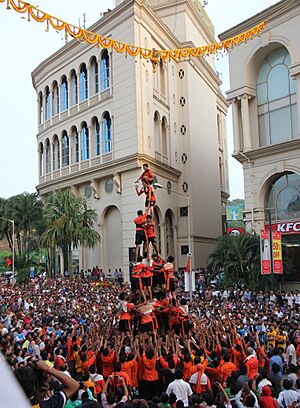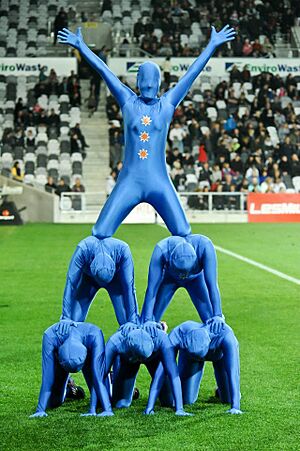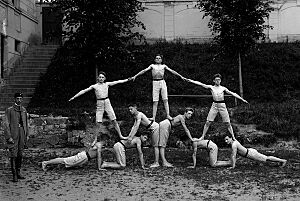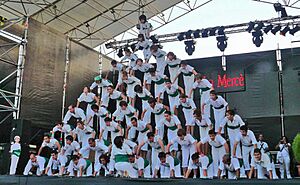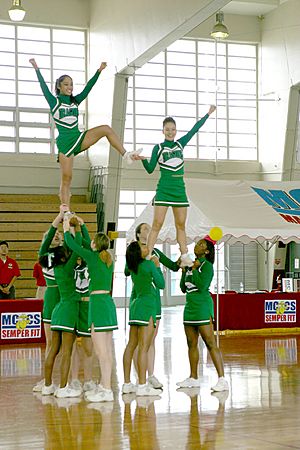Human pyramid facts for kids
A human pyramid is an amazing acrobatic shape made by three or more people. In these formations, some people stand or kneel on the shoulders, backs, or thighs of others. This creates different levels, with people on lower levels supporting those above them. Usually, each lower level has more people than the one above it. This makes the whole structure look like a triangle, just like a pyramid!
To make these pyramids strong and safe, lighter people usually go on the higher levels. Stronger and heavier people form the base, providing a solid foundation. You can see human pyramids in many exciting activities. These include cheerleading routines and amazing circus acts.
Contents
What Are Human Pyramids?
Human pyramids are a type of acrobalance. This means balancing people on top of other people. It takes a lot of teamwork, strength, and balance to build one. Imagine a team working together perfectly to create a living structure! These formations are not just about strength. They also show great coordination and trust among the participants.
Where Do We See Human Pyramids?
People around the world have been building human pyramids for hundreds of years. They are part of many different cultures and celebrations.
Ancient Traditions and Festivals
Human pyramids are a big part of several cultural events. They often celebrate history, strength, and community spirit.
China's Bun Festival
In China, human pyramids are sometimes formed during the exciting Bun Festival. People build these pyramids to reach for special buns placed high up. It's a fun and challenging part of the festival!
Czech Sokol Movement
The Czech Sokol movement started in Prague in 1862. It was a group focused on sports and gymnastics for young people. The Sokol movement helped people stay fit and strong. Human pyramids were one of the many cool exercises they practiced. This movement also spread to other Slavic countries.
India's Dahi Handi
During the Hindu festival of Krishna Janmashtami in Maharashtra, India, young men create human pyramids. Their goal is to reach and break pots filled with curd and butter. These pots, called Dahi Handi, hang high above the ground. It's a joyful and competitive ritual.
Spain's Tower Builders
Spain has a rich tradition of human pyramids. These are often called "human towers."
- The town of Algemesí hosts a Human Pyramid Festival every year on September 8. This festival is part of the Fiesta de La Virgen de la Salud, celebrating the Virgin of Good Health. Acrobats, known as muixeranga, build these impressive human towers.
- In Catalonia, groups called "castellers" build incredible human pyramids. These are known as castells, meaning "castles." Some castells can be as tall as ten people high! Many statues in Catalonia celebrate this ancient tradition. For example, in Tarragona, castellers build towers during the Santa Tecla Festival in September. They also perform during the Sant Magi festival in mid-August.
- The Falcons are another traditional team in Catalonia. They also build human pyramids and towers. Their rules are a bit different from those of the castells.
Venetian "Forze d'Ercole"
In Venice, Italy, people used to build human towers until the 1700s. These towers were called "Forze d'Ercole," or "Forces of Hercules." They were built by people from different parts of Venice, the Castellani and Nicolotti. These towers could have up to eight levels of men. A child, often called the Cimiereto, would stand at the very top.
Human Pyramids in the United States
In the United States, human pyramids are used in various ways.
- Boy Scouts and Girl Scouts sometimes have competitions. Patrols race to build a human pyramid using all their members. The fastest patrol wins!
- University performance groups also use human pyramids. They create large-scale balancing acts. For example, the University of Maryland Gymkana Troupe builds many pyramids in their shows. The Washington Adventist University Acro-Airs combine cheerleading skills and tumbling. They create three-person high pyramids in their performances.
Cheerleading Pyramids
Cheerleaders often include human pyramids in their routines. These pyramids can feature difficult stunts and gymnastics. In cheerleading, pyramids are groups of stunts connected in the air by the "flyers." Flyers are the people at the top of the pyramid. They might link hands or even act as bases for other flyers on top of them. This creates multi-level pyramids that are exciting to watch.
Why Is Safety Important?
Building human pyramids requires careful practice and safety measures. Because people are balancing on each other, there is always a risk of falling. It is very important to have trained coaches and spotters. Spotters are people who stand ready to catch anyone who might fall. Following safety rules helps everyone enjoy building pyramids without getting hurt. Many organizations and schools have strict guidelines to ensure safety during these activities.
See Also
- Acrobalance
- Acrobatic gymnastics
- Castell
- Dahi Handi, a similar tradition in India.
- Gymnastic formation
- Human tower (gymnastic formation)
- Muixeranga


